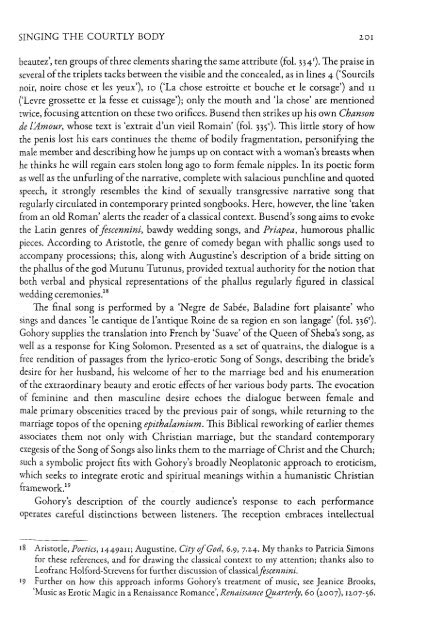obscenites renaissantes - ePrints Soton - University of Southampton
obscenites renaissantes - ePrints Soton - University of Southampton
obscenites renaissantes - ePrints Soton - University of Southampton
You also want an ePaper? Increase the reach of your titles
YUMPU automatically turns print PDFs into web optimized ePapers that Google loves.
SINGING THE COURTLY BODY<br />
loi<br />
beautez', ten groups <strong>of</strong> three elements sharing the same attribute (fol. 3340- The praise in<br />
several <strong>of</strong> the triplets tacks between the visible and the concealed, as in lines 4 ('Sourcils<br />
noir, noire chose et les yeux'), 10 ('La chose estroitte et bouche et le corsage') and 11<br />
('Levre grossette et la fesse et cuissage'); only the mouth and 'la chose' are mentioned<br />
twice, focusing attention on these two orifices. Busend then strikes up his own Chanson<br />
de I'Amour, whose text is 'extrait d'un vieil Romain' (fol. 335"). This little story <strong>of</strong> how<br />
the penis lost his ears continues the theme <strong>of</strong> bodily fragmentation, personifying the<br />
male member and describing how he jumps up on contact with a woman's breasts when<br />
he thinks he will regain ears stolen long ago to form female nipples. In its poetic form<br />
as well as the unfurling <strong>of</strong> the narrative, complete with salacious punchline and quoted<br />
speech, it strongly resembles the kind <strong>of</strong> sexually transgressive narrative song that<br />
regularly circulated in contemporary printed songbooks. Here, however, the line 'taken<br />
from an old Roman' alerts the reader <strong>of</strong> a classical context. Busend's song aims to evoke<br />
the Latin genres <strong>of</strong>fescennini, bawdy wedding songs, and Priapea, humorous phallic<br />
pieces. According to Aristotle, the genre <strong>of</strong> comedy began with phallic songs used to<br />
accompany processions; this, along with Augustine's description <strong>of</strong> a bride sitting on<br />
the phallus <strong>of</strong> the god Mutunu Tutunus, provided textual authority for the notion that<br />
both verbal and physical representations <strong>of</strong> the phallus regularly figured in classical<br />
wedding ceremonies.'®<br />
The final song is performed by a 'Negre de Sabee, Baladine fort plaisante' who<br />
sings and dances 'le cantique de I'antique Roine de sa region en son langage' (fol. 336').<br />
Gohory supplies the translation into French by 'Suave' <strong>of</strong> the Queen <strong>of</strong> Sheba's song, as<br />
well as a response for King Solomon. Presented as a set <strong>of</strong> quatrains, the dialogue is a<br />
free rendition <strong>of</strong> passages from the lyrico-erotic Song <strong>of</strong> Songs, describing the bride's<br />
desire for her husband, his welcome <strong>of</strong> her to the marriage bed and his enumeration<br />
<strong>of</strong> the extraordinary beauty and erotic effects <strong>of</strong> her various body parts. The evocation<br />
<strong>of</strong> feminine and then masculine desire echoes the dialogue between female and<br />
male primary obscenities traced by the previous pair <strong>of</strong> songs, while returning to the<br />
marriage topos <strong>of</strong> the opening epithalamium. This Biblical reworking <strong>of</strong> earlier themes<br />
associates them not only with Christian marriage, but the standard contemporary<br />
exegesis <strong>of</strong> the Song <strong>of</strong> Songs also links them to the marriage <strong>of</strong> Christ and the Church;<br />
such a symbolic project fits with Gohory's broadly Neoplatonic approach to eroticism,<br />
which seeks to integrate erotic and spiritual meanings within a humanistic Christian<br />
framework.''<br />
Gohory's description <strong>of</strong> the courtly audience's response to each performance<br />
operates careful distinctions between listeners. The reception embraces intellectual<br />
18 Aristotle, Poetics, i449aii; Augustine, City <strong>of</strong> God, 6.9, 7.24. My thanks to Patricia Simons<br />
for these references, and for drawing the classical context to my attention; thanks also to<br />
Le<strong>of</strong>ranc Holford-Strevens for further discussion <strong>of</strong> classical fescennini.<br />
19 Further on how this approach informs Gohory's treatment <strong>of</strong> music, see Jeanice Brooks,<br />
'Music as Erotic Magic in a Renaissance Romance', Renaissance Quarterly, 60 (2007), 1207-56.
















